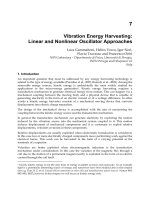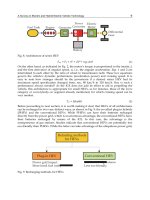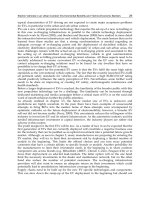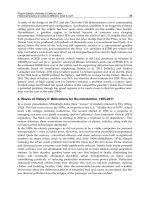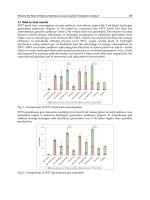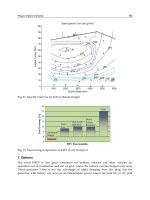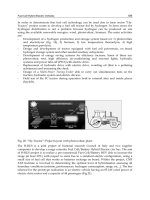Electric Vehicles The Benefits and Barriers Part 10 docx
Bạn đang xem bản rút gọn của tài liệu. Xem và tải ngay bản đầy đủ của tài liệu tại đây (879.47 KB, 20 trang )
Communication with and for Electric Vehicles
169
street. Having a contract with every single provider is very uncomfortable. Hence,
mechanisms to enable AAAA for roaming are inevitable. In order to guarantee a user-
friendly e-mobility roaming experience, there are several challenges to cope with. Paying
cash or via credit card is uncomfortable and requires more expensive infrastructure than
identifying as a user through an adequate contract.
5.2 Challenges of roaming
On the base of the above understanding of e-mobility roaming and its business context, a
closer look is taken at the preconditions of roaming. Since roaming involves two or more
parties, the preconditions are closely related to questions of interoperability and the use of
standards. Preconditions of roaming can be grouped into electrical and commercial issues,
each concerning aspects of the underlying medium or its use (Fig. 11).
electrical
medium
commercial
use of medium
I
II
III
IV
Fig. 11. Categories of requirements for roaming in e-mobility infrastructure
For example, a straight forward requirement for an electrical medium (I) is – assuming
conductive charging – a standardized EV plug. Since the usage of adapters is very
uncomfortable, an EV plug should fit into the outlet of all EVSE. The International
Electrotechnical Commission (IEC) therefore currently revises the international standard
IEC 62196. Considering other ways of getting power into an EV, such as induction or battery
exchange, different requirements must be fulfilled. For inductive charging, a consistent form
and position of the charger and the inductor is vital. For the battery exchange, especially the
size and interface of the batteries as well as the security concept must be compatible. Beyond
pure physical characteristics of the underlying medium, there is a need for its standardized
use (II). For example, successful conductive charging requires voltage, current, frequency
and charge mode to be correctly adjusted on both sides as well as to the cable diameter.
These basic parameters can be negotiated via a control pilot signal as defined in SAE J1772.
From a commercial point of view, the charging of an EV requires a medium for containing
or conducting data for authentication, authorization and accounting (AAA) (III).
Authentication of a user in front of an EVSE could be done for instance via RFID cards,
magnetic or smart cards, key panels or near field communication by cellular phones.
Alternatively, authentication data can be transferred via a communication line directly
out of the EV. In order to exchange the commercially relevant data, the use of the media
must be further specified by standards for protocols and data types (IV). Considering
protocol aspects, the standard IEC 15118 is currently developed. It will enable the
automatic exchange of information between an EV and an EVSE. Therefore, standard
message types for transferring session, status, metering and billing data are defined on
different layers of the OSI Model. In addition to protocols using the communication
connection, there is a clear commercial need for the definition of basic identifiers (IDs)
that can be used throughout the information systems of involved companies. The
remainder of this paper focuses on identification issues and discusses possible and
necessary IDs for roaming with EV.
Electric Vehicles – The Benefits and Barriers
170
5.3 Identifiers for roaming
Every Identifier (ID) has a certain scope in which it is valid. For roaming, the distinction of
intra-company and inter-company IDs (henceforth called uniform IDs) is essential. While
intra-company IDs such as customer numbers are sufficient for many commercial
applications, roaming requires uniform IDs for involved objects to allow for inter-company
data exchange. Since uniform IDs require significant standardization efforts, it is worth to
investigate which IDs should to be uniform in which cases. The cases clearly depend on the
underlying business model(s) and technical choices. However, two abstract scenarios can
cover many of them. Both scenarios differ from each other only with respect to the sequence
of communication steps (Fig. 12).
EVSE Operator
EV User
E-Mobility
Provider
B1
A1
A4, B2
A2
A5, B3
A3
Fig. 12. Two scenarios for the sequence of communication steps
In scenario A, the EV User (or its EV on behalf of him) passes all information needed for
authentication through the EVSE (A1) to the EVSE Operator (A2). The EVSE Operator
forwards the information to the E-Mobility Provider and requests AAA for the EV User
(A3). If the response (A4) is positive, the EVSE Operator unlocks the EVSE for charging (A5).
In scenario B, the EV User directly connects to the E-Mobility Provider (B1) for AAA. If
authorization is successful, the E-Mobility Provider requests the EVSE Operator (B2) to
unlock the particular EVSE for charging (B3).
Required
provider need to know which
operator to contact
Optional
operator known by provider
EVSE
Operator
Optional
EVSE known by operator
Optional
EVSE known by operator
EVSE
Optional
user known by provider
Optional
user known by provider
EV User
Optional
provider known by operator
Required
operator need to know which
provider to contact
E-Mobility
Provider
Scenario BScenario AIdentifiers
Required
provider need to know which
operator to contact
Optional
operator known by provider
EVSE
Operator
Optional
EVSE known by operator
Optional
EVSE known by operator
EVSE
Optional
user known by provider
Optional
user known by provider
EV User
Optional
provider known by operator
Required
operator need to know which
provider to contact
E-Mobility
Provider
Scenario BScenario AIdentifiers
Fig. 13. Requirement of uniformity depending on scenario
Communication with and for Electric Vehicles
171
Investigating four roaming relevant IDs reveals that – with respect to the need for
uniformity – each scenario requires at least one uniform ID (Fig. 13). However, even where
uniform IDs are optional, standardization of such IDs is advantageous. Assuming scenario B
with authentication of an EV user by a cellular phone, the EV user needs to transfer the IDs
of the EVSE and the EVSE Operator to the E-Mobility provider. If the EV User is required to
manually type these numbers in his cellular phone, the usability decreases considerably
when all EVSE Operators use very different formats for these IDs. Very comfortable would
be an App that allows to take a picture of a code (e.g. bar code, matrix code, or simply
number in standardized format) in order to get the EVSE ID on the smartphone.
6. Conclusion
At the beginning of this chapter, it was motivated why the energy transmission to EV is of
high relevance. Its character of a fixed and intersection point was explained. For this fixed
and intersection point, three fundamental dimensions, namely the electrical, the
organizational and the informational dimension, were presented and discussed. Afterwards,
the informational dimension was further detailed with the help of an information system.
The relevance and usage of the information system finally was illustrated by the example of
e-mobility roaming.
All in all, with EV being at the point of broader market penetration, the question of the
informational integration of these EV into infrastructure and its interaction with user
services becomes more important. Although, information and communication technology
has to be seen as a helpful enabling technology of EV usage, it has to be stated that ICT itself
needs resources to efficiently serve the requirements of EV stakeholders.
Even though many activities have already started (cf. standardization), a lot of more effort is
needed to efficiently and economically use ICT for EV. The proposed overview of an
information system that explicitly combines the user perspective with ICT components at an
adequate chosen fixed and intersection point (“energy transmission”) can be a good starting
point for the integration of on-going research activities and derivation of further research
questions.
7. Acknowledgment
This work was supported by the German Federal Ministry of Economics and Technology
(Smart Wheels: Grant 01ME09020; Smart Watts: Grant 01ME08015).
8. References
Bolczek, M. (2010). Business Models for Electric Vehicles. Proceedings of the 2nd European
Conference on Smart Grids and E-Mobility, p. 34, ISBN 978-394185144. Brussels,
Belgium, October 20-21, 2010
Federal Motor Transport Authority (2011). Emissionen, Kraftstoffe - Deutschland und
seineLänder am 1. Januar 2011. 17.3.2011. Available from
ionenKraftstoffe/2011__b__emi__eckdaten__absolut.html
German National Platform for E-Mobility, NPE (2010). The German Standardization Roadmap –
E-Mobility Version 1. Figure 12, p. 28. 30.11.2010. Available from:
Electric Vehicles – The Benefits and Barriers
172
/>Roadmap_Elektromobilit%E4t.pdf
Heinrich, L.J. & Lehner, F. (2005). Informationsmanagement. Oldenbourg.ISBN 978-
3486577723, München, Germany
Kempton, W. & Letendre, S (1997). Electric vehicles as a new power source for electric
utilities, In: Transportation Research Part D – Transport and Environment 2 (3), Elsevier
Science Ltd., pp. 157-175, Great Britain
Kempton, W & Tomic, J. (2005a). Vehicle-to-grid power implementation: From stabilizing
the grid to supporting large-scale renewable energy, In: Journal of Power Sources 144
(1), Elsevier Science Ltd., pp. 280-294, Great Britain
Krcmar, H. (2006). Information Management, Springer, ISBN 978-3540206286, Berlin,
Germany
Kempton, W & Tomic, J. (2005b). Vehicle-to-grid power fundamentals: Calculating capacity
and net revenue, In: Journal of Power Sources 144 (1), Elsevier Science Ltd., pp. 268-
279, Great Britain
Rand, D.; Woods, R. & Dell, R. (1998). Batteries for electric vehicles, Research Studies Press
Ltd., John Wiley and Sons Inc., ISBN 978-0863802058, N.E. Bagshaw
Scheer, A W. (2000). ARIS - Business Process Modeling, Springer, ISBN 978-3540658351,
Berlin, Germany
Schiller, J. (2003). Mobile Communications, Addison Wesley, ISBN 978-0321123817, p.113,
München, Germany
Sovacool, B. & Hirsh, R. (2009). Beyond batteries: An examination of the benefits and
barriers to plug-in hybrid electric vehicles (PHEVs) and a vehicle-to-grid (V2G)
transition, In: Energy Policy 37 (3), Elsevier Science Ltd., pp. 1095-1103, Great Britain
The Open Group (2009). The Open Group Architecture Framework - TOGAF Version 9. Van
Haren Publishing, ISBN 978-9087532307, Great Britain
Tomic, J. & Kempton, W. (2007). Using fleets of electric-drive vehicles for grid support, In:
Journal of Power Sources 168 (2), Elsevier Science Ltd, pp. 459-468, Great Britain
Zwicky, F. (1967). The morphological approach to discovery, invention, research and
construction, pp. 273-297 In: New Methods of Thought and Procedure. Contributions to
the Symposium on Methodologies, May 22-24, 1967, Pasadena. Springer-Verlag, New
York. 17.3.2011. Available from:
10
Applications of SR Drive Systems
on Electric Vehicles
Wang Yan, Yin Tianming and Yin Haochun
Beijing Jiaotong University/Beijing Tongdahuaquan Ltd. Company/Tsinghua University
China
1. Introduction
As the continuous growth of global vehicle production and owned, the problems brought by
vehicles are conspicuousness day after day. These problems are much more serious in
China. Thus developing zero emission electric vehicles have become the main scientific
research projects in many countries around the world in 21st century. Energy-saving motor
drive technology has become one of the key points to the EV commercialization.
In the present electric vehicles, there are several main drive systems include the chopping
system of DC motor, the variable frequency drive system of induction motor(IM), the drive
system of permanent-magnet motor(PM) and switched reluctance drive system(SRM), etc.
The DC machine has been faded gradually in the electric vehicle drive system for the reason
of high startup current, huge volume, low efficiency and poor reliability. Even worse, the
carbon body and the commutator which are not suited for high speed movement need to be
changed frequently. The variable frequency drive system of IM has a small torque
fluctuation, but with low efficiency especially in the low speed stage. When the electric
vehicle is grade climbing, the torque output is small and the current is high. Although the
permanent-magnet motor is of high efficiency, the manufacturing technique is very
complicated and the machine will lose effectiveness because of the demagnetization in high
temperature. So it is not the perfect way. The structure of the SR Motor is firmly and stable.
The SRD system has a high reliability, wide range of speed regulation, high efficiency, low
startup current and large torque output, all of which are especially suited for the work
condition of the electric vehicles. The application of SRD on electric vehicles is affected by
the torque fluctuation and strong noise. In a word, performance comparisons of the three
motors are indicated in the following table 1.
Because of its own characteristics,electric vehicles motor drive system should meet the
following demands:
1. Output a large torque under base speed to meet the requirement of starting,
accelerating, climbing and some other complicated working conditions.
2. Output constant power above the base speed in order to adapt max speed, overtaking
and so on.
3. Maximize motor efficiency over the whole speed range to extend endurance mileage.
From the table, the SRM has more advantage than the other motors.
Many control different strategies have been proposed for the torque fluctuation task . Full
rotor pitched insulating non-magnetic colloid techniques of SRM and SRM fuzzy logic
Electric Vehicles – The Benefits and Barriers
174
adaptive torque control system based on instantaneous torque sum are proposed in this
chapter.
Motors
Items
IM PM SRM
System efficiency lower higher higher
Starting torque lower higher highest
Power density lower highest higher
Workmanship simple complicated simplest
Reliability higher lower highest
Life
longer short longest
Manufacturing cost
lower highest lowest
Table 1. Performance comparisons of IM, PM and SRM
2. Design of SR motor on EV
The noise sources can be divided into four broad categories: magnetic, mechanical,
aerodynamic and electronic . Therefore, according to the magnetic flux in the machine
passing across the air gap in an approximate radial direction producing radial forces on the
stator and rotor result in magnetic noise and vibrations, selection of 12/8 construction is
used in the SRM design and a new rotor structure is proposed in this section.
2.1 Electric vehicle power demand
The selection of driving motor on electric vehicles mainly depends on rated power and rated
speed. The more power grade is choosed the more reserve-power is got and the better
vehicle driving feature is. But the volume and weight of the motor will increase rapidly by
the same time and lead to the decline of the motor efficiency. So, the motor power should
not too large. The calculation of power matching of EV motor is as follows:
A simplified model of the road vehicle dynamics can be used to estimate the tractive
requirement of the vehicle drive-train, from which the individual component specifications
can be rated with-regard-to their peak and continuous duties. The vehicle model accounts
for the resultant forces acting against the vehicle when starting and when in motion, as
illustrated in following figure 1. These forces can generally be considered as comprising of
four main components, viz.:
dwra
j
FFFFF
(1)
Applications of SR Drive Systems on Electric Vehicles
175
Fig. 1. Vehicles dynamics analysis
Where the force to overcome the tyre to road power loss, or rolling resistance, Fr =
kr
mg
cos
, a resistive force related to the road gradient, F
w
=mg
sin
, an aerodynamic
resistance or drag force, Fa=1/2
C
d
A
f
v
2
, and the transient force required to accelerate or
retard the vehicle, F
j
=m
dv/dt. Where:-
kr is the rolling resistance coefficient which includes tyre loss and is approximated to be
independent of speed and proportional to the vehicle normal reaction force; m is the vehicle
and payload mass; is the road gradient; g is the gravitational constant; is the density of
air; Cd is the drag force coefficient; A
f
is the vehicle frontal area, and v is the vehicle linear
velocity. Having determined the forces acting upon the vehicle, the road wheel torque can
be calculated from the equation of motion, viz.:
w
ww
f
wd
d
TJ drF
dt
(2)
Where J
w
,
w
, r
w
, are the wheel inertia, angular velocity and mean radius, respectively, and
d
f
is a factor proportioning torque distribution on the rear axle. By way of example, for a
direct rear wheel drive scenario, it is assumed that there is an equal share of the required
tractive force between each wheel drive machine (i.e. d
f
= 0.5). For an on-board drive
machine option, a gear stage is included in the drive-train, thus the output torque of the
traction machine is related to the road wheel torque by the total transmission gear ratio, n
t
,
transmission efficiency,
t
, and the machine rotor inertia, J
m
. Incorporating these into the
equation of motion yields a general expression for traction machine torque:
1
m
mm w
tt
d
TJ T
dt n
(3)
Expressing the wheel and traction machine angular velocities in terms of the vehicle linear
velocity yields:
w
w
v
r
(4)
mt
w
v
n
r
(5)
Electric Vehicles – The Benefits and Barriers
176
From which the machine torque equation can be expressed in terms of the vehicle linear
velocity by substituting eqns.(1), (2), (4) and (5) into eqn.3:
2
1
cos sin
2
fw fw
tm w
mrdf
w ttw tt tt
drm dr
nJ J
dv
TkmgCAv
rnrndtn
(6)
Mechanical power is torque multiplied by mechanical speed:
mmm
PT
(7)
Acording to the confirguration of the PEUGEOT 505 SW8 showed in table 2, the drive motor
power can be calculated using above equations.
26.36
m
PkW
.Considering batteries
(weight 650 kg) will be added on the vehicle, the motor should be enlarged to 30kW.
the weight with full load 2000kg
rolling resistance coefficient 0.0267
air resistance coefficient 0.3
windward area 1.75m
2
the average efficiency of motor 0.94
the density of air 1.205Kg/m
3
the road gradient
15
the max speed of EV 180km/h
Table 2. The parameters involved are listed in table 2.
Assume there are two motors with same rated power, the one with higher rated speed is
smaller and lighter. In the view of vehicle performance, there will be less mechanical loss if
the rated speed is higher. Meanwhile, it can provide large speed range to the drive system.
Although the higher rated speed is favorable, the drive gear will be much more and more
complicated. So, the above mentioned factors should be all considered in the selection of
motor rated speed.
2.2 Designed SRM for PEUGOT 505 SW8
The parameters design of SR drive motor are contained the preliminary selection of frame
size, the number of stator poles Ns and the number of rotor poles Nr, the stator and rotor
pole angle selection, the bore diameter and the stack length, the selection of the conductor
and the winding design, the calculation of the minimum and maximum inductance
according to specifications for the SRM selected above, viz. 30kW, 4000r/min, 300v SRM.
Then the motor verification is designed by Finite Element Analysis.
Following are the parameters of SR drive motor (Table.3), we choose 300V lead acid storage
battery as power supply system. The mortor’s performance curves are showed in figure 2,
3,4. The fig.2 gives the profile of flux linkage vs. current of unaliagned and aliagned stator
and rotor tooth. The fig. 3 decribes when the rotor’s angel changing, the stator’s winding
current changs. The fig.4 represents the composed torque of the motor changes with the
angel. It shows big variety occurs commutation between the winding phase A and B or
Band C et. Thus measurement should be taken to avoide the torque ripple.
Applications of SR Drive Systems on Electric Vehicles
177
Rated power
(kW)
30 Rated voltage (V) 300 Rated speed (r/min) 4000
Poles and phase 12/8, 3
Maximum value
of phase
inductance (mH)
3.98401
Minimum value of
phase inductance
(mH)
0.379135
Effective rated
value of phase
current(A)
88.6784
Motor average
efficiency
0.94
Rotary inertia(kg*m
2
) 0.0486939
Table 3. The parameters of SR drive motor
Fig. 2. Profile of designed SRM flux-linkage-current
Fig. 3. Profile of designed SRM current vs. angle
unaligned
aligned
Current (A)
0 200 100 50 150
0.179336
0.043495
0.086790
0.130285
Flux Linkage (Wb)
Electric Vehicles – The Benefits and Barriers
178
Fig. 4. Profile of designed SRM composed torque vs. angle
2.3 New rotor structure
There are large spaces between the present SRM rotor teeth, which will cause strong noise
when the rotor rotating. A new type of rotor structure is proposed in the chapter. Figure 5
(a) shows the originally one, (b) (c) is the new structure diagrammatic sketch.The structure
include 1 shaft, 2 rotor tooth, 3 yoke part
, 4 screw bolt and nut, 5 insulating non-magnetic
colloid, 6 copper collar, 7 steel ring. The insulating non-magnetic colloid is filled in the yoke
part between rotor teeth. The two copper collars which are used to fix insulating non-
magnetic colloid by screw bolt and nut are connected through the rotor shaft.
The expansion factor of insulating non-magnetic colloid is similar to rotor silicon-steel sheet,
which can avoid the fissure between insulating non-magnetic colloid and rotor teeth. There
are small amount of heat and noise when the new SRM rotor structure is applied during
high speed rotating. It is obvious that the working efficiency is higher than the existing one.
Fig. 5. A novel rotor structure for SRM
2.4 Drive mode for PEUGEOT 505 SW8
At beginning development of electric vehicles, inorder to concentrate to develope battery
cell and drive motor system, electric vehicles conversion design is usually adopted. The
most defferent between the electric and regular fuel vehicles is energy system. Dynamic
Applications of SR Drive Systems on Electric Vehicles
179
system of the EV is composed of battery system and drive motor system. The battery
provides direct current supply. The supply passing through electric apparatus which is
made of controller and power main electical circuit is changed into electical power which
can be used by the motor. Then the motor runs and the wheels are drived. The energy
power transmission is showed in following figure 6.
The PEUGEOT 505 SW8 is a kind of wagon which is drived by rear-wheel. So the
conversion EV can be designed as the motor connecting to gear-box via clutch, transaxle
driving the wheels through transmission shaft. The drive mode is shown in figure 7.
Fig. 6. The power transport process of EV
1- motor, 2-clutch, 3-gear-box, 4-transmission shaft, 5-transaxle, 6-steering gear
Fig. 7. Drive mode for PEUGEOT 505 SW8 conversion
3. SR drives power converter
The cost and performance of the SRM drive have been determined by many or converter
topologies invented, and unlike the conventional inverts-fed induction machine, the SRM
drives are highly dependent on the convert topology used to dive the SRM. An asymmetric
half bridge converter topology is adopted in the 3-Phase SRM drive for EV, which is showed
in figure 8. The main electrical circuit composes of power electrical lead acid batteries U
s
,
support capacitor C
s
, asymmetric half bridge IGBTs from V11 to V62 and freewheel diodes
from VD11 to VD62. It permits control of the individual phases fully independent of each
other and thus permits the widest freedom of control. During normal operation, the
electromagnetic flux in an SR motor is not constant and must be built for every stroke. In the
motoring period, these strokes correspond to the rotor position when the rotor poles are
approaching the corresponding stator pole of the excited phase. In the case of Phase A,
Electric Vehicles – The Benefits and Barriers
180
shown in figure 8, the stroke can be established by activating the switches V11 and V42. At
low-speed operation the Pulse Width Modulation (PWM), applied to the corresponding
switches, modulates the voltage level. When the switches V11 and V42 are turned off in the
same time, producing transformer electromotive force in Phase A break-over forward
freewheel diodes VD11 and VD42, the Phase A current after flows through VD11, VD42 and
Cs. Each of V11 with its anti-parallel diode VD11 and V12 with its anti-parallel diode VD12
is the asymmetric half bridge structure in the one IGBT module. KDC is a DC contactor
which powers up to the drive system, and is controlled by key of the vehicle which starts the
engine originally.
Fig. 8. Schematic Diagram of Power converter in Electrical Vehicle
3.1 Parameter selection of the main circuit
The driving power U
s
is composed of 25 series lead acid batteries which rated voltage is
12V, capacity is 85Ah. Thus the whole volume of U
s
is 300V. Because safety working
voltage arrange of the single battery is from 10.5V to 14.4V, the actual group of batteries
working voltage arrange is from 262.5V to 360V. Selecting maximum DC bus voltage 360V,
in the asymmetric half bridge main circuit the main switch IGBT will bear the maximum DC
power voltage from the bus. Considering twice surplus capacity, the IGBT withdraw voltage
is in equation 8.
rsmax
U 2U 2 360V 720V
(8)
The effective rated value of the phase current for the designed SRM is 88.6784A, considering
the overloade current of the drive system two multiple of the phase current, the effective
rated value of the IGBT current is in equation (9).
srms N
2 2 88.6784A 177.3568AII
(9)
Having determined the effective rated value of the IGBT current , the peak current of the
IGBT can be calculated in equation (10), viz
^
S
N
2 2 q 434.3553AII (10)
Applications of SR Drive Systems on Electric Vehicles
181
In the equation (9), m is the number of the phase of the SRM which eaquals 3 in the system.
Actually power converter parameters involved in the designed SR drive motor are listed in
table 4. To sum up , the main circuit switch IGBT can be selected as BSM300GA120DLC of
EUPEC which has 1200V bear voltage (
0
80
C
TC ), 300A effective current value, 600A peak
current value (
1
p
tms
).
Electrical parameters Values
Average current of main switch 46.1426 A
Effective current of main switch 84.7971A
Peak current of main switch 188 A
Average current of after flow bidiode 11.878A
Effective current of after flow bidiode 27.0406 A
Peak current of after flow bidiode 138A
Table 4. Designed Parameters of SR Drive Motor
3.2 IGBT drive and snubbed electronic circuits design
IGBT is simply voltage driven switches, because their insulated gate behaves like a
capacitor. Conversely, switches such as triacs, thyristors and bipolar transistors are
“current” controlled, in the same way as a PN diode. Because IGBT gate drive condition is
closely related to its static and dynamic performance. The turn-on voltage, switching time,
switching loss, short-circult withstand capability etc. are ordinately effected by positive and
negative voltage (V
GE
and - V
GE
) between gate and emitter, gate electrode resistance (R
G
).
Being reasonably designed drive and protection circuit is quite important.
3.2.1 IGBT drive conditions
The concrete requirement of IGBT drive circuit is listed flowering.
(1)Because IGBT is a type of voltage drive module, it has a threshold voltage value of 2.5 V
to 5.0V and has a capacitive input resistance. IGBT is very subtle to electric charge
accumulation of the gate electrode, so the drive circuit must be very reliable to grantee there
is a discharge loop with a low resistance itself, viz. there is as short as possible wire between
the circuit and IGBT.
(2)Charging and discharging the gate oxide capacity with small interresistance drive supply
inorder to gurantee that the gate electrode controlling voltage has much enough steep
forward and reverse edge. Because IGBT has nonlinear capacitive character, the driver must
have enough instantaneous absorbing current capability. Thus the gate electrode voltage can
be set up or disappear soon inorder to decrease the switch loss lowerly. On the other hand,
after the IGBT turns on, the gate electrode driver should supply enough power to avoide to
be destroyed because of exit saturation. The drive interresistance can not be lower than
commanded R
G
, otherwise there will have underdamped harmonic motion between the
stray inductance and the gate electrode capacity in the drive loop . Meanwhile, the surge
current increases during short switching time. This induces booth unsafty in the main circuit
and disturbance in the control circuit.
(3)Although the higher + V
GE
, the higher current limit becomes, + V
GE
should be remained
under maximum rated G-E voltage, + V
GES
=+20V. The reason is once there is a over current
Electric Vehicles – The Benefits and Barriers
182
or short current, the higher + V
GE
, the higher current, the bigger probability of the IGBT
destroy becaues the time of enduring short current capability decreases. Usually, the value
of + V
GE
is considered as between 12V and 15V.
(4)Set the enough gate reverse bias voltage value(-V
GE
) to IGBT. While the IGBT is in off-
state, there are some high frenquency osillation signals in the gate electrode circuit because
the other part circuits are stiill working. These signals may let IGBT to be in micro on-state,
it results in the power loss of IGBT increase. Therefore a recommended -V
GE
to IGBT is -5V
to -10V (the maximum gate reverse bias voltage value is -V
GES
=-20V ), so that the IGBT can
be cut off reliably even if there are switch noises in the gate electrode of IGBT .
(5) The gate electrode resistance effects R
G
on the switch loss, switch speed, and even
involves in whether the drive circuit appears oscillation and the collector electrode
generates surge current. Usually the value of R
G
can not be selected to be over 10 times than
the producer recommended value. In actual application, R
G
should be ajusted carefully. R
G
should be disposed closely to the gate electrode.
(6) There should be have a gate electrode amplitude limiting circuit to avoid to
breakthrough the gate electrode.
(7) The drive circuit should be isolated from the control circuit so that, when the IGBT is
destroyed the other components can not be damaged. When the IGBT burns, the collector
electrode high voltage usually pwties the drive circuit through destroyed the gate electrode,
and then disrupts some components in the drive circuit . The gate electode drive circuit as
far as possible should be simple and actual. It is much better that the IGBT itself has
protection and very strong the ability of disturbance. When the IGBT is under the state of
load short circuit or over current, the IGBT can prevent fault current automatically through
decreasing the gate electrode voltage gradually to be switched the IGBT off softly. That is to
prevent very high di/dt causing by the fault current because of IGBT turn-off swiftly . The
high value di/dt can produce high spiking voltage under the stray inductance function,
results in the IGBT to be unbearable and damaged. By the same rule, the soft turn-off
process of the drive circuit should not be effected by the input signal disappear. The drive
circuit should have a time logical for thegate voltage control function. When there has over
current, no matter whether there is the input signal, the drive circuit should be turned off
unconditionally.
3.2.2 IGBT drive electrinic circuits design
The IGBT-driving hydrid IC EXB841 produced by Fuji Electric is used in the EV power
convter. It can drive 300A/1200V or 400A/600V IGBT moduel and the drive signal delay
reaches 1.5
µs, the maximum switching speed is 40KHz. The drive circuit is designed in
figure 9 arround EXB841, in which C1 and C2 are two electrolytic capacitors to absorb the
chang of supply voltage. MC1413,LED,R1,R2 are composed of the drive line from the
control circuit to EXB841. V3 and V4 are two voltage-stabilizing diodes to limit amplitude
of EXB841 output drive voltage, so that to avoide the drive voltage higher and destroy the
IGBT. V3 and V4 are two voltage-stabilizing diodes which are in inverted series and
connected in parallel with collector and emitter electrode. The over current protective
circuit for IGBT is composed of R3, E1,R4, V1 and V2, in which V1 and V2 connecting to
the sixth pin of EXB841 completes to monitor the collector electrode voltage. V1 is the fast
recover diode which is ERA 34-10 made from Fuji Electric. V2 is the voltage-stabilizing
Applications of SR Drive Systems on Electric Vehicles
183
diode which can change the controlled point of the current protection by adjusting the
voltage-stabilizing value of the diode. Theoretically, if the over current protection of
EXB841 takes effect is that the pin of EXB841 outputs a low electrical level when the
collector electrode voltage monitoring the six pin is greater than 7.5V. Then the opto-
coupler in the figure outputs a fault signal to the control board which is high level OC
signal. The signal produces interruption on the board and controls CPU to block trigger
pulse for IGBT. The theoretical protective value 7.5V of EXB841 is the operating point
which the supply voltage is strictlly controlled at 20V. When the supply voltage has ripple
or error, the protective value will change. When the supply voltage is greater than 20V,
the protective value increases 1V as the supply voltage does. When the supply voltage of
EXB841 is 20V, the drive voltage suppllied IGBT turning on is 15V. According to the
profile of switching losses of IGBT-inverter of BSM300GA120DLC, the curve of collector
electrode current vs. IGBT switching on voltage drop V
CE
can be abttain. The voltage drop
between the gate and the emitter electrode can be calculated in the following equation and
figure 10.
0CE C
VRIV
(11)
Fig. 9. IGBT drive circuit
According to the figure 10 and 11, when
vj
T 125 C
, IGBT output curve can be linearized
by line y=Ax+B. Known the three points on the curve, respectively they are (2.0,208),
(2.5,325), (3.0,465). Using the points (2.0,208) and (2.5,325), the equation is listed in 12.
0.0042735 1.01282
CE C
VI
(12)
Taking
480
C
IA , 3.0641
CE
VV , the error of V
CE
and the percent rate of error are listed in
following equations.
3.0641 3.06 0.0041
CE
V
(13)
Electric Vehicles – The Benefits and Barriers
184
0.0041
100% 0.133%
3.06
(14)
Fig. 10. IGBT BSM300GA120DLC output curve under different voltage
When the drive voltage suppllied IGBT turning on is 15V, the collector electrode current is
600A, IGBT switching on voltage drop V
CE
is about 3.5V calculated by 12 and in figure 10.
Then the value of voltage-stabilizing diode V2 is selected as 9V. From the table 5, the gate
resistance value can be chossed 3.3.
Fig. 11. Positive output characteristic curve of power devices
V
CE(sat)
=V
0
+RI
C
V
F
=V
0
+RI
F
V
CE
(
sat
)
or V
F
V
0
I
C
or I
F
R
Applications of SR Drive Systems on Electric Vehicles
185
IGBT Rating 600V 200A 300A 400A -
1200V 200A 150A 200A 300A
R
G
12 8.2 5 3.3
Icc 5kHz 20mA 22 mA 23 mA 27 mA
10kHz 24 mA 27 mA 30 mA 37 mA
15kHz 27mA 32 mA 37 mA 47 mA
Table 5. Recommended the gate resistance R
G
and the current loss
3.2.3 IGBT snubbed electronic circuits design
When the power electronic device is used, buffer electronic circuit should be designed to
inhibit respectively di/dt and dv/dt when the device switched on and off. The aim is to
change switch locus of the device in order to avoid the maximum value of V
CE
and i
C
appear
at same time. Thus the switching loss is decreased and reliability can be improved. T he
IGBT snubbed electronic circuit is put particular emphasis on the voltage absorbing and
restraining in switch on state. That is because the IGBT working switch frequency is very
high, tiny inductance in the electronic circuit can cause very big L di/dt and produce over
voltage to endanger the IGBT security. RCD snubbed electronic circuit is often used which is
designed in figure 12. The RCD bridges joint every IGBT module connecting with two ends
of the power. Capacity and resistance value selection has much more relationship with
snubbing voltage in the snubbed electronic circuit. If the selection is improper, it would
affect the voltage absorb so far as to bring about osillation in the circuit.
Within the IGBT switching off process, the current of device drops fastly, the current in the
snubbed circuit increases at same change rating. The magnetic energy stored in the parasitic
inductance in the main electronic circuit will wholly transfere into the electrical energy in
the absorbing capacity. Assumming the current flowing the main switch device drops
linearly when switching off, the current flowing the snubbed circuit increases linearly
because the switching off process is very short. These two current can be expressed in the
following equations.
T
f
t
i(1 )I
t
(15)
CT
f
t
iIi I
t
(16)
In the equations,
i
T
is the current in the main switch device; i
C
is the charging current in the
absorbing capacity;
t
f
is dropping time when switching off. I is the average current in the
direct current bus line. Therefore, the voltage of capacity two ends is expressed in the
equation 17.
ff
tt
f
CS C
00
f
11tIt
UidtIdt
CCt2C
(17)
Electric Vehicles – The Benefits and Barriers
186
Fig. 12. IGBT snubbed elctronic circuit.
The capacity voltage
U
CS
usually can be selected as 10 to 50 percent of the supply voltage
U
DC
at t
f
. For example, selecting
CS DC
U0.5U , the capacity C is in the following equation.
f
DC
It
C
U
(18)
The value of the absorbing capacity can be selected as 0.47
µF according to the the equation
18 and experience value. The selection rule of resistance
R is to releasing electric charge
thouroghly stored in the snubbed capacity before the IGBT switching off signal comes. If
R
is too large, it makes the discharging time of the capacity
C lower. But if R is too small, the
discharging current is too large and fast when the IGBT switching on, it can endanger the
device security and cause the osillation. So period (
T) of the switch device eaquals 1 or 2
times of 3
RC. So the value of the resistance R can be calculated in the equation 19.
1
R
6Cf
(19)
R calculated by the equation 19 can not be greater than 41.72 ohm , 39ohm is selcted in the
RCD snubbed circuit. The maximum power loss on the absorbing resistance can be
calcultaed as in the equation 20.
2
1
20
2
R
PCVfW
(20)
The fast recovery diode is selected as FR607. Beside the IGBT drive and snubbed electronic
circuits design, the switched power supply circuit and control circuit should be designed.
Because the length of the chapter, the content cannot be covered all the bases. As figure 13
shows, the control circuit structure of SRD system is given. With MICM2002 (Motor
Intelligent Module) based on DSP and AT89C51 singlechip the folowing control strategy is
realized. When the EV is powered, the controller goes into working state. The control signal
from all kinds of fault signals and the driver operating system are coded and loaded the
Applications of SR Drive Systems on Electric Vehicles
187
AT89C51 through prior coder. If the system is checked with no fault and no operation, the
system is in standby mode. When the driver gives the start and throttle given signal,
according to the SRM rotor position signal from the position sensor, the singlechip sends out
the phase turn on/off signal and the MCIM produces the PWM signal, then the system
integrates the protective and the current chopping signals to give the main circuit IGBT
drive signal and control the power main circuit to supply the SRM windings electricity and
move the motor. According to the positive and negative rotation setting and the position
information of the motor, the singlechip controls the windings power-on sequences. When
the motor rotates at low speed, current chopping control mode can be used. Firstly, the chip
gives the upper limitation of the current chopping signal and puts it into the MICM through
D/A converter; secondly, the MICM comparates the current limitation with the phase
current detecting from the current sensor, then calculates, optimizes and sends out the
chopping signal. When the motor speed arrives above basic speed, the control mode
changes into angle control from the current chopping control. When the driver changes the
operting signal, the control circuit changes the working logic and implements
corresponding dive requirement through the power circuit. If there is fault in the motor
running, the control circuit blocks the trigger pulse of IGBT and protects IGBT, and displays
and alarms through display circuit. Meanwhile it communiates with CAN module and
sends the fault signal to driver video facility.
Fig. 13. Control circuit structure of SRD systems
Electric Vehicles – The Benefits and Barriers
188
4. SRM fuzzy logic adaptive torque control system
For the reason of the non-linearity in magnetic circuit, the SRM is hard to analyze and
control. Also, it is difficult to build an accurate mathematical model. The fuzzy control are
mainly applied to the system which is severely non-linearity or hard to get the mathematical
model. The fuzzy adapative control to the SRD system is proposed in order to further
increase the speed regulating precision and minimize the torque fluctuation. This chapter
presents a new type of SRM control system which combines the PI regulator and fuzzy logic
control
-the SRM fuzzy logic adaptive torque control system based on instantaneous torque
sum.
4.1 Speed PI regulator design
Figure 14 presents the principal frame of SRM fuzzy logic adaptive control. The
conventional PI regulator is applied in the external loop and the fuzzy logic adaptive control
based on instantaneous torque sum is used in the inner loop system. According to the
voltage balance equation of SR motor:
a
isa a sa a sa
aa
asaa
di
ddLa
VRi Lai Ri La i Ri
dt dt dt
di di
dLa dθ dLa
La i R i La i ω
dt dθ dt dt dθ
(21)
Suppose the inductance change rate is constant, which defined as
L
g .
a
L
dL
g
dθ
(22)
So the equation 21 can be written as following equation.
a
isLa
di
VRωgi La
dt
(23)
Fig. 14. Principal frame of SRM fuzzy logic adaptive direct torque control system
Speed PI
regulator
+
-
ω
r
ω
-
+
Torque order
△
τ(ψ,i)
△τ(ψ,i)
Calculation of
current order
Control logic of
optimal current
and angle
△
τ(ψ,i)
ψ(
△
τ,θ)
Fuzzy logic table
ω
d
t
d
θ
SRM
Rotor persition sensor
Hall current sensor
Calculation of
instantaneous torque
τ(ψ,i)
ψ(i,θ)
i
θ
θ
θ
i
θ
△i(ψ, τ)
